By Paula Schlueter Ross
How can The Lutheran Church–Missouri Synod — an overwhelmingly white, Anglo church body with a nonwhite membership of less than 5 percent — become more multicultural?
How can the historically German LCMS help African-Americans, Asians, Hispanics, Native Americans and others feel welcome and “at home” in its congre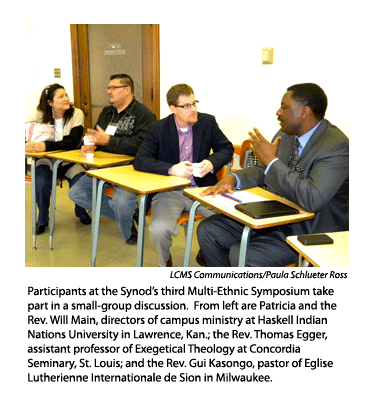 gations?
gations?
One word: relationships. Welcoming others, getting to know them, being a friend.
That’s just one of many insights shared at the third Multi-Ethnic Symposium, “Gifts of Hope,” held Jan. 30-31 at Concordia Seminary, St. Louis. The two-day gathering offered perspectives from Lutherans of various ethnicities, workshops on “best practices” from the mission field, panel and small-group discussions, and worship.
It was, says the Rev. Dr. Andrew H. Bartelt, “a wonderful mix of ethnicities and cultures, working together to be the one body of Christ that expresses both a unity of faith and a diversity of culture.”
It also was an intentional effort, he added, “to move beyond the ‘conversations of hope’ [the theme of the previous symposium in 2010] from within the minority communities themselves into engagement with the Anglo majority, including our own [seminary] students, whose ministry will be shaped by the multi-cultural society into which they are sent.”
Bartelt, vice-president of Academic Affairs at the seminary and a member of the symposium planning committee, said the gathering’s focus was threefold:
- to hear “from the ethnic communities their expressions of the ‘gifts of hope’ that the multiplicity of cultures brings to the body of Christ.”
- “to engage the Anglo majority in listening and learning — not necessarily leading.”
- “to include both theory and practice” in presentations and discussions.
Attending the symposium were about 100 LCMS leaders representing a variety of ethnic groups nationwide, plus faculty and students from Concordia Seminary.
The Rev. Dr. Leopoldo A. Sánchez, director of the seminary’s Center for Hispanic Studies, who has attended and  helped plan all three Multi-Ethnic Symposiums, said this year’s gathering “had a nice mix of essays, reactions, presentations and sectionals from leaders of various ethnic communities.” Sánchez led off the two-day event with his presentation, “Dealing with Culture Theologically — Music as a Test Case for Exploring Models of Theology and Culture.”
helped plan all three Multi-Ethnic Symposiums, said this year’s gathering “had a nice mix of essays, reactions, presentations and sectionals from leaders of various ethnic communities.” Sánchez led off the two-day event with his presentation, “Dealing with Culture Theologically — Music as a Test Case for Exploring Models of Theology and Culture.”
The recent symposium “was even more valuable” than the others, he told Reporter, because the seminary’s faculty voted to cancel classes so that students could attend.
“We wanted and needed that interaction from students,” Sánchez said, “since they will be the ones sent out to parishes and mission fields in a U.S. that is increasingly non-Anglo.”
In one symposium session, speakers shared perspectives from their ethnic communities, addressing what the Lutheran church has given them, what their culture offers the church, and ideas for making the LCMS more multicultural.
The Rev. Will Main, a Sioux Indian, said the Synod has a “very honorable” and long history in Native American ministry so there is already “a spirit of brotherhood” between the two cultures.
Main explained the importance of drum and flute music among Native Americans, saying it “bypasses the mind and speaks directly to the heart,” and played a drum solo for symposium attendees. Among Native Americans’ gifts to the churc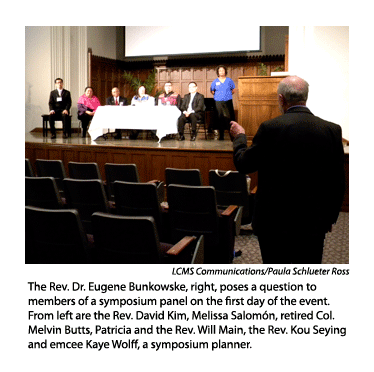 h is “our sense of humor,” he said. “We love nothing better than to laugh.”
h is “our sense of humor,” he said. “We love nothing better than to laugh.”
Main invited participants to look around the auditorium of some 100 people of various ethnicities to see “how it will look in heaven,” and he said it is possible for the LCMS to become more multicultural.
“We’re going to get there by creating relationships,” he said, and he encouraged Synod members to “get to know the people” of other cultures and become friends who “walk together” in ministry.
Main and his wife, Patricia, who is Cree, serve as directors of campus ministry at Haskell Indian Nations University in Lawrence, Kan.
The Rev. Kou Seying, the first ordained Hmong pastor in the LCMS, said he was grateful for the “clarity of the Gospel” the Synod has brought to the Hmong people.
Because “mothers” are very influential in the Hmong culture, Seying encouraged pastors to “please bring your wife along in your ministry.”
He said the LCMS has “a choice to make: remain small, basically exclusive and irrelevant, or we take risks and embrace the multi-ethnic church and be influential in the mission of the church throughout the world.”
Lutherans, he said, are not known for being the friendliest people on Sunday morning, and “that has to change.”
Moreover, the church “must learn to listen” to others, he said, and its leadership must include people of various ethni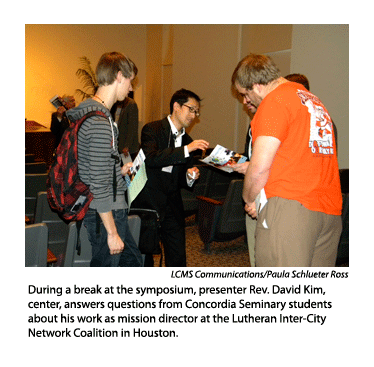 cities so that “the voiceless must become the voice to be heard.”
cities so that “the voiceless must become the voice to be heard.”
The Rev. David Kim, mission director at the Lutheran Inter-City Network Coalition in Houston, said the Synod’s “sound Lutheran theology” has been “a huge gift to me.”
Kim said his fellow Koreans have great respect for their elders and for pastors, they “pray a lot,” and many, like him, are “crazy about church-planting.”
The Synod at-large, he said, must learn to “mutually share and learn” with and from those of other cultures, create partnerships — pastor-to-pastor, circuit-to-circuit, seminary-to-seminary — so parties can share their strengths, and “invest in local leaders.” Kim challenged each LCMS pastor to raise up one pastoral candidate for seminary training.
Melissa Salomón, who serves mission-planting ministries in Tijuana, Mexico, and Chula Vista, Calif., pointed out that when Hispanics welcome someone to their home that person becomes “part of the family.” Their natural inclination is to be inclusive, she said, and that’s something they can share with the LCMS.
In order to become more multicultural, the Synod needs to recognize the gifts of other ethnic groups and make a conscious effort to welcome them. That won’t be easy, she said, but “it is part of the beauty that God intends for us.”
An African-American perspective was provided by retired Col. Melvin Butts, who spent 26 years in the Army; served on the faculty of several colleges, including Concordia College, Selma, Ala.; and currently is an adjunct professor 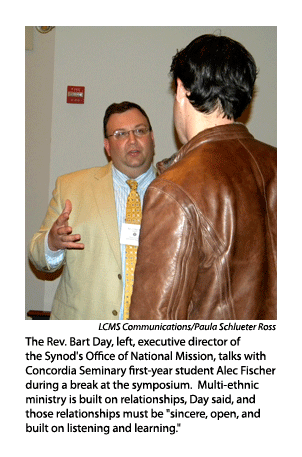 at Concordia College — New York, Bronxville, N.Y.
at Concordia College — New York, Bronxville, N.Y.
Butts called African-American Lutherans “unique resources” who can help the Synod understand the challenges of integration and sharing the Gospel within a multi-ethnic society.
With Asian, Hispanic and African-American populations in the U.S. projected to double and triple over the next 40 years, Butts said it is “imperative that we seize opportunities to witness to persons of all cultures, as our Savior calls us to do,” and he encouraged Synod members to “view all people as those for whom Christ died” and interact with them “in a sincere, loving and non-prejudicial way.”
He said Lutherans “must go out and become an integral part of our communities, and open our church doors to the people, inviting them to [join] us.”
He told of an experience he and his wife, LuJuana, had 11 years ago, as they were celebrating an anniversary in Anchorage, Alaska. On a Sunday morning they located an LCMS church for worship, and found they were the only blacks in attendance. After the service an older couple introduced themselves to the Butts, talked with them during fellowship, and then insisted on giving them a tour of the city and treating them to lunch.
“We were tremendously grateful,” Butts said, and he called the experience “an example of unconditional love and hospitality shown toward persons of a different race, emphasizing that together we are brothers and sisters in Christ.”
If the LCMS wants to become more multi-ethnic, its members, he said, “should go and do likewise. For this is what we believe, teach and confess, and this is who we are in Christ Jesus.”
A discussion on “perspectives from church leadership” featured three panelists:
- The Rev. Dr. Larry Stoterau, president of the LCMS Pacific Southwest District and chairman of the Council of Presidents, said ethnic diversity “begins in the local congregation and the pastor’s willingness to learn.”
- The Rev. Roosevelt Gray Jr., mission director for the LCMS Michigan District, encouraged congregations to be “inclusive,” “indigenous” (by training congregation leaders from all ethnic groups) and “innovative” in their cross-cultural ministries.
- the Rev. Bart Day, executive director of the Synod’s Office of National Mission since Aug. 1, said he came to his current post from a congregation and school in Houston that had students from 22 countries. “The ethnic church is the church of the future,” he said, and if the Synod fails to become a multi-ethnic church, it will “die.”
Stoterau said pastors need to be willing to do two things: “listen and eat.” He advised them to “listen to people and let them know you care about them,” which can be done while sharing meals with them.
Gray said there are more than 90 million people of non-Anglo ethnicities in the United States today who are “waiting to hear from us about a God who loves them.”
Multi-ethnic ministry is built on relationships, Day said, and those relationships must be “sincere, open, and built on listening and learning.” Holistic ministry that addresses spiritual — and physical — needs also is important to reach ethnic groups, he said.
Day called Lutheran schools one of the “greatest assets” of the LCMS for multicultural outreach, and called on the Synod to plant more schools, especially in urban areas. College campuses provide “huge opportunities” to reach international students, he said, adding that some 95 percent of foreign students are never invited to an American’s home during their time in this country.
He also introduced the idea of a “Lutheran Youth Corps” that would give college students opportunities to take part in cross-cultural servant events worldwide.
The Rev. John C. Wille, president of the LCMS South Wisconsin District and one of seven or eight district presidents who attended the symposium, said the experience was “very valuable, both to myself and to the cross-cultural missionaries t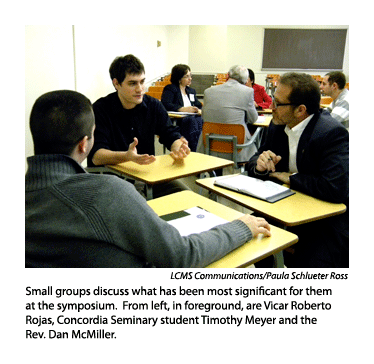 hat we brought along.”
hat we brought along.”
Said Wille: “If we are going to be more than a Lutheran church with a German heritage, if we truly embrace the Gospel message, it is essential that we not only send missionaries overseas but that we also see the mission field at our front door — literally, people of every nation, tribe and language living in our neighborhoods and communities right now.”
Timothy Meyer, a 24-year-old first-year student at Concordia Seminary, told Reporter he’s glad he attended the symposium, which “functioned as a catalyst for some truly insightful and engaging conversation.”
Meyer said he “appreciated the chance … to simply sit back and listen to the many presenters and speakers from such a wide array of roles and ethnicities — all of whom have a heart for the incarnational mission of Christ in the world. I loved soaking it in.”
He added that the symposium “opened my eyes to some major challenges the LCMS will be facing in the upcoming years and is, in fact, facing right now” and offered “a plethora of practical advice and suggestions concerning what I, a lowly seminarian, can be doing right now to help prepare me for a multicultural ministry in a multicultural world.”
Other ideas and comments that surfaced during panel discussions, question-and-answer periods, and small-group talks included:
- Make scholarships available so that children of all ethnicities can attend Lutheran schools. With a Lutheran education, more children from nonwhite cultures may become professional church workers, and that would benefit the Synod’s multicultural outreach.
- For pastors: spend half of your workweek out of the office, visiting and eating meals with people in order to build relationships.
- Open your church doors to help children with their homework. Include devotions, and invite their families to worship.
- “Ministry is a people business. You’ve got to love people.” You’ve got to be “where the people are, and where the needs are.”
- Stop thinking about people as ethnic groups — instead, see them as fellow human beings.
- Today’s young people typically have friends of many different cultures. Adopt their approach — “less handwringing … more excitement” — and involve them in cross-cultural ministry.
Posted March 9, 2012




